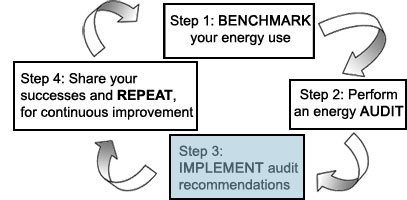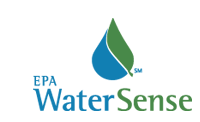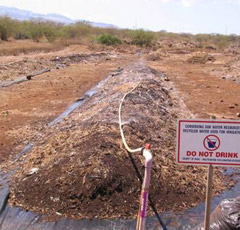Sustainable Water Infrastructure Contacts
Pacific Southwest, Region 9
Serving: Arizona, California, Hawaii, Nevada, Pacific Islands, Tribal Nations
Water & Energy Efficiency in Water and Wastewater Facilities
| Sustainable Water Infrastructure Quick Finder | ||||
|---|---|---|---|---|
| FundingGreen Jobs in the Water SectorLow Impact Development | Waste To Biogas Mapping ToolWater Conservation/EfficiencyWater-Energy Connection | Water Loss ControlWhy Sustainability? | ||
Water Conservation

Can wastewater and water facilities conserve water? Absolutely! In fact, wastewater and water utilities across the nation are saving substantial amounts of water by encouraging water efficiency and conservation. Promoting the use of water conservation devices and practices to customers through Web sites and via promotional material on water/sewage bills can significantly help reduce water and wastewater infrastructure costs as well as conserve resources for future generations. Facilities don't need to create their own water conservation outreach material as EPA has already done this through its WaterSense Program. Additionally, wastewater treatment facilities can reuse treated wastewater to water city parks and golf courses, and to irrigate agricultural land. They can also recycle some of the treated wastewater for reuse onsite during cooling processes.
Water can be conserved at homes and businesses to reduce the amount of water going to a wastewater treatment facility. Water can be saved through leak detection programs in the distribution lines.
Water Audits
Water Audits not only identify real water losses (e.g. leakage), but also apparent losses (e.g. unbilled, unmetered consumption). Free water audit software is available on AWWA's web site. ![]()
Additional Water Audit Resources
The California Urban Water Conservation Council has developed a list of Best Management Practices to help water suppliers implement in water conservation programs. Learn more about BMPs like Water Survey Programs for Single-Family Residential and Multi-Family Residential Customers, Retail Conservation Pricing, System Water Audits, Leak Detection and Repair, and Conservation Programs for Commercial, Industrial, and Institutional (CII) Accounts at the CUWCC Web site ![]() .
.
WaterSense

WaterSense seeks to protect the future of our nation's water supply by promoting water efficiency and enhancing the market for water-efficient products, programs, and practices. But why would a water utility want to sell less water? Utilities and their customers can benefit substantially when they use water more efficiently. Sales losses can be offset when treatment, disposal, and energy costs come down because less water is processed. On average, these savings can offset about 30 percent of the losses associated with selling less water. Water and wastewater utilities can promote the use of water efficient products with their customers thereby enhancing their own ability to conserve water.
Energy Star Portfolio Manager ![]() can help you track your water use.
can help you track your water use.
Water Recycle and Reuse
Wastewater recycling helps you get the most from limited water supplies. In addition to providing a dependable, locally-controlled water supply, water recycling provides tremendous environmental benefits. By providing an additional source of water, water recycling can assist in identifying ways to decrease the diversion of water from sensitive ecosystems, decrease wastewater discharge, and reduce pollution. Recycled water can also be used to create or enhance wetlands and riparian habitats. EPA Region 9 has a Web site dedicated to water recycling and reuse.
Case Studies
Benefits of water conservation are demonstrated in these examples:
City of Clovis, California
In 2009, the City of Clovis’ Water Reuse Facility
began producing up to 2.8 million gallons per day (MGD) of highly-treated recycled water. Until the early 1970's, groundwater was the sole source of water for Clovis. The groundwater levels dropped and many wells were going dry. The city turned to the Fresno Irrigation District for access to surface water. Some of the water from the Fresno Irrigation District is used for groundwater recharge, some is sent to the water treatment facility to be treated to tertiary recycled water standards and the rest of the water is used untreated to irrigate city parks and common use areas.
In light of projected water balance needs, Clovis recognizes the importance of recycled water as a much needed new water source. The wastewater treatment facility will ultimately produce 9,400 acre-feet of "disinfected tertiary treated recycled water" annually through a membrane bioreactor facility. The Recycled Water System will then carry this highly-treated water to irrigate green belts, median islands, parks, trails and paseos, State Route 168, and agricultural operations throughout the city.
Maui County, Hawaii
 Maui County Water Reuse for Agriculture
Maui County Water Reuse for AgricultureMaui County's water reuse program results in 22% of their recycled water being reused. For fiscal year 2008, they treated an average of about 14,000,000 gallons of wastewater per day and reused about 3,100,000 gallons of recycled water per day. The recycled water is used for agricultural irrigation (seed corn, pineapple, pasture irrigation, composting), landscape irrigation (golf courses, parks, schools, condominiums, shopping centers, highway road shoulders, median strips), cooling, and construction uses. The program results in potable water savings of approximately 400,000,000 gallons annually.
Lahaina and Kihei spent $39 million upgrading their facility to produce R-1 quality (highest quality) water; with this money they also installed new pumping equipment, distribution pipelines, storage facilities and other related equipment. The facilities used a combination of financing strategies to pay for the recycled water system. They floated bonds and used the State Revolving Fund to initially finance these improvements. The pay back period is 20 years. They charge for their recycled water, but set rates comparable to conventional water sources. They also subsidized the program with sewer user fees.
Conserving water is an ever increasing need, especially in the arid west. Water recycling and reuse is vital to maintaining our water supply. Water and wastewater facilities that recycle and reuse water are making great strides in conserving one of our most precious and scarce resources.
